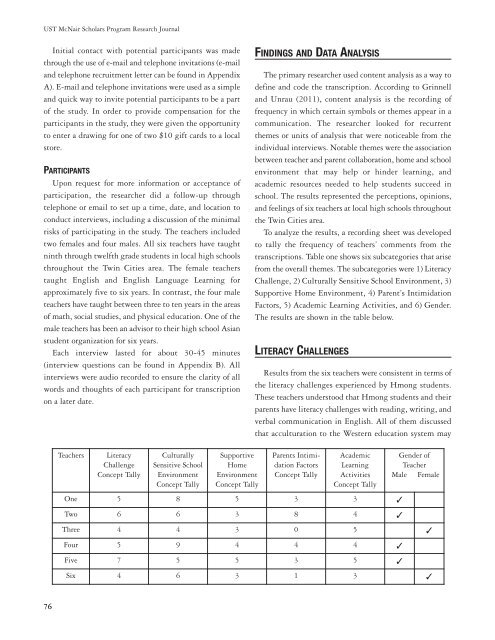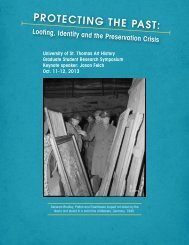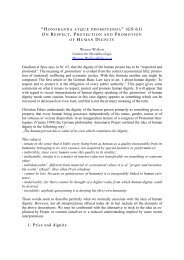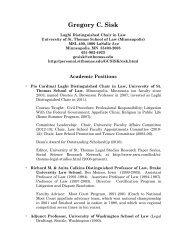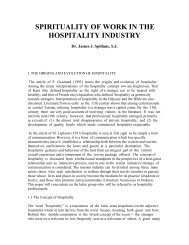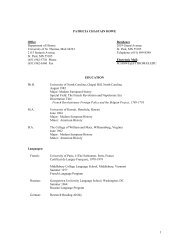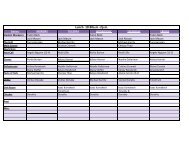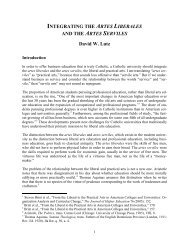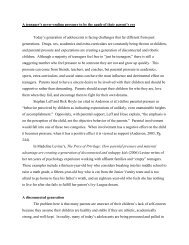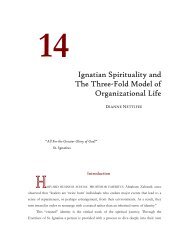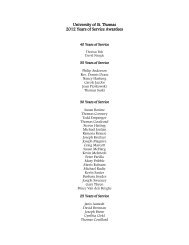dr. ronald e. mcnair acknowledgements - University of St. Thomas
dr. ronald e. mcnair acknowledgements - University of St. Thomas
dr. ronald e. mcnair acknowledgements - University of St. Thomas
You also want an ePaper? Increase the reach of your titles
YUMPU automatically turns print PDFs into web optimized ePapers that Google loves.
UST McNair Scholars Program Research Journal<br />
Initial contact with potential participants was made<br />
through the use <strong>of</strong> e-mail and telephone invitations (e-mail<br />
and telephone recruitment letter can be found in Appendix<br />
A). E-mail and telephone invitations were used as a simple<br />
and quick way to invite potential participants to be a part<br />
<strong>of</strong> the study. In order to provide compensation for the<br />
participants in the study, they were given the opportunity<br />
to enter a <strong>dr</strong>awing for one <strong>of</strong> two $10 gift cards to a local<br />
store.<br />
PARTICIPANTS<br />
Upon request for more information or acceptance <strong>of</strong><br />
participation, the researcher did a follow-up through<br />
telephone or email to set up a time, date, and location to<br />
conduct interviews, including a discussion <strong>of</strong> the minimal<br />
risks <strong>of</strong> participating in the study. The teachers included<br />
two females and four males. All six teachers have taught<br />
ninth through twelfth grade students in local high schools<br />
throughout the Twin Cities area. The female teachers<br />
taught English and English Language Learning for<br />
approximately five to six years. In contrast, the four male<br />
teachers have taught between three to ten years in the areas<br />
<strong>of</strong> math, social studies, and physical education. One <strong>of</strong> the<br />
male teachers has been an advisor to their high school Asian<br />
student organization for six years.<br />
Each interview lasted for about 30-45 minutes<br />
(interview questions can be found in Appendix B). All<br />
interviews were audio recorded to ensure the clarity <strong>of</strong> all<br />
words and thoughts <strong>of</strong> each participant for transcription<br />
on a later date.<br />
76<br />
Teachers Literacy<br />
Challenge<br />
Concept Tally<br />
Culturally<br />
Sensi tive School<br />
Environment<br />
Concept Tally<br />
Supportive<br />
Home<br />
Environment<br />
Concept Tally<br />
FINDINGS AND DATA ANALYSIS<br />
The primary researcher used content analysis as a way to<br />
define and code the transcription. According to Grinnell<br />
and Unrau (2011), content analysis is the recording <strong>of</strong><br />
frequency in which certain symbols or themes appear in a<br />
communication. The researcher looked for recurrent<br />
themes or units <strong>of</strong> analysis that were noticeable from the<br />
individual interviews. Notable themes were the association<br />
between teacher and parent collaboration, home and school<br />
environment that may help or hinder learning, and<br />
academic resources needed to help students succeed in<br />
school. The results represented the perceptions, opinions,<br />
and feelings <strong>of</strong> six teachers at local high schools throughout<br />
the Twin Cities area.<br />
To analyze the results, a recording sheet was developed<br />
to tally the frequency <strong>of</strong> teachers’ comments from the<br />
transcriptions. Table one shows six subcategories that arise<br />
from the overall themes. The subcategories were 1) Literacy<br />
Challenge, 2) Culturally Sensitive School Environment, 3)<br />
Supportive Home Environment, 4) Parent’s Intimidation<br />
Factors, 5) Academic Learning Activities, and 6) Gender.<br />
The results are shown in the table below.<br />
LITERACY CHALLENGES<br />
Results from the six teachers were consistent in terms <strong>of</strong><br />
the literacy challenges experienced by Hmong students.<br />
These teachers understood that Hmong students and their<br />
parents have literacy challenges with reading, writing, and<br />
verbal communication in English. All <strong>of</strong> them discussed<br />
that acculturation to the Western education system may<br />
Parents Intimi -<br />
dation Factors<br />
Concept Tally<br />
Academic<br />
Learn ing<br />
Activities<br />
Concept Tally<br />
One 5 8 5 3 3 ✓<br />
Two 6 6 3 8 4 ✓<br />
Gender <strong>of</strong><br />
Teacher<br />
Male Female<br />
Three 4 4 3 0 5 ✓<br />
Four 5 9 4 4 4 ✓<br />
Five 7 5 5 3 5 ✓<br />
Six 4 6 3 1 3 ✓


